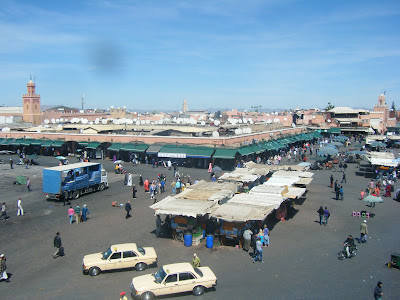We took the bus from the airport to Djemaa el-Fna in Medina (known as "big square" - if you look like you are lost the locals will shout "big square" at you and expect a tip to point you back towards Djemaa el-Fna. Realistically you should never need directing back to the big square as the largest minaret in the Marrakesh skyline is that of the Koutoubia Mosque, which is visible across the city and located right next to Djemaa el-Fna.)
 |
| Djemaa el-Fna |
One of the things that became apparent when trying to find our hotel was that addresses are approximate locations, one road may have more than one name, and even with an exact address very few streets actually have name signs to tell you which street they are. It's probably a good idea to get a taxi from the airport if you are visiting for the first time. The airport is only bout 6 miles out of the city and a fixed price can be agreed with the driver prior to the journey.
We returned to Djemaa el-Fna the next morning to begin exploring and nothing could have prepared me for what I saw. The open area of the square is full of snake charmers, monkey handlers, dancers and henna painters all keen to lure you in. The henna ladies will try to draw on your hand, the snake charmers put a snake around your neck and you may even find a monkey jumping onto your shoulder. There's no mention of money and it's easy to get lured in, especally on your first visit to the square. Of course they all expect money and will ask for crazy amounts and follow you across the square if they don't think you have paid them enough. However it's all part of the Marrakesh experience and the atmosphere is second to none.
 |
| Caught by the snake charmers |
The snake charmers got us on our first visit to the square and tried to charge us the equivalent of £8 each for the experience and for taking this photo, and we're pretty certain Tim's snake was dead!! Just remember very few prices in Marrakesh are fixed and you can barter with the street traders as much as anyone else. They will do their best to make you feel guilty and will always try and push prices up but walking away and ignoring them once you've parted with as much cash as you are willing does eventually work and they'll just move onto some other tourists.
After escaping the square entertainment it's advisable to take a minute with one of the orange juice vendors. Freshly squeezed orange juice is 4 dirhams (about 30p) and is to die for. You'll need it before heading into the souks (markets).
The souks are like rabbit warrens filled with little market stalls. We found the easiest way to approach them was to just follow them through until we'd had enough, find an exit then reorientate ourselves by spotting the Koutoubia minaret. It's virtually impossible to keep track of where you are in the souks and that's all part of the fun. They are roughly organised into sections so you'll find several stalls selling the same thing clustered together. Spice square is well worth a look for the mounds of colourful spices, but custom regulations make buying any spices to take home pretty difficult. There are no fixed prices in the souks and I made a decision not to buy anything the first day. Instead I looked at what was available and decided what I would like to take home with me.
 |
| The souks from above - complete with satellite dishes! |
In terms of prices the general rule in the souks is to ask a price, start bartering at a third of the asking price and don't pay more than half. Use the fact that there are many similar stalls to your advantage - the traders know you can walk away and get the same thing elsewhere. Traders will try every trick in the book to get you to pay more, usually stating their goods are better quality than the identical ones on the next stall. Be willing to walk away from a sale which is just not going in your favour - remember you can find an identical product just round the corner.
If the souks are really too much for you then visit the Centre Artisanal in Kasbah (just down the road from the Saadian tombs - also well worth a visit). Here you will find the same goods as in the souks at fixed prices. You're more likely to be sure of the quality but you can get identical products in the souks for cheaper. However the air-conditioned building, with toilets and noone pestering you can be a tempting place to buy anyway. Discerning shoppers will use the prices here, find what they want to buy then go back to the souks to barter a better price. Using the Centre Artisanal prices as the top price you are willing to pay, it's far easier to be confident when haggling in the souks. And if your bartering fails, you can just return to the Centre Artisanal to buy!
Marrakesh can be hard work but it's hard not to fall in love with the place once you get used to it. Having been traumatised on my first visit to the square, four days later I really didn't want to leave.













